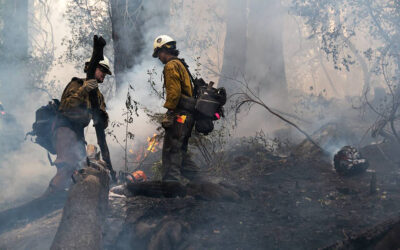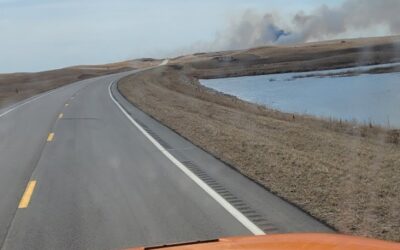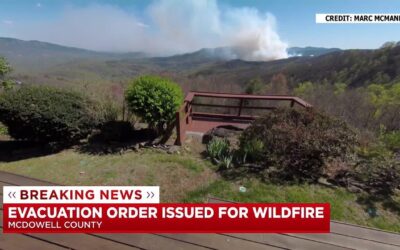Apr. 10—When the Retreat Fire exploded into a serious threat for people and homes last summer, forcing the closure of U.S. Highway 12 for three and a half weeks, it took the combined efforts of several agencies to contain the blaze.
Although the fire consumed two homes and burned more than 45,000 acres, firefighters from partners such as the Washington’s Department of Natural Resources, Department of Fish and Wildlife, and the U.S. Forest Service, and other agencies along with an out-of-state incident management team, managed to protect Tieton, Cowiche and other areas from what could have been significantly more damage. Similar coordinated efforts across the state limited 93% of fires to less than 10 acres, resulting in more than 300,000 acres burned, well below the 10-year average.
As another fire season approaches, it appears those agencies could be working with fewer resources and less capacity due to federal and state budget cuts. DNR spokesperson Michael Kelly said normal preparation’s ongoing but they’ll be closely watching what happens in Olympia and expect less help from federal employees due to the Trump administration’s decision to fire 3,400 Forest Service employees and 125 in Washington, mostly in recreation departments, back in February.
A Forest Service hiring freeze announced by the Biden administration last November exempted wildfire-related positions. But the Trump administration made no such exemption when it announced a hiring freeze of federal civilian employees on Jan. 20, stalling the onboarding of thousands of seasonal firefighters.
“I think the biggest issue for us is this chaos at the federal level, are people fired or are they not fired?” Kelly said. “Is there funding for this or is there not funding? That makes it really hard to plan for a wildfire season.”
Court orders last month forced the Forest Service to rehire those probationary workers it fired, and The Seattle Times reported some of them returned to their jobs two weeks ago. But some will come back later or not at all due to voluntary retirements or finding other jobs, and Kelly said even those who do come back will be behind on valuable training and the status of seasonal firefighters remains unclear.
In a statement, the Forest Service said it maintained its permanent wildland firefighting positions and “will ensure they have the training, tools, and resources they need to work alongside our state and local partners, as well as private landowners, to continue the work to protect lives and livelihoods.”
The national fire season’s already started, including major incidents causing billions of dollars of damages in California, Oklahoma and North Carolina. Kelly said it’s clear combatting wildfires will require a big state and federal response.
“Having fewer firefighters at the federal level will just mean that states have to step up, and we’ll be able to step up, but that’s going to strain resources and that’s going to strain capacity,” Kelly said. “It’s just creating a situation that we didn’t need to create.”
Washington state’s $12 billion budget deficit could cause additional strain, since legislators have discussed not funding the full $125 million appropriated to fighting wildfires in a 2021 bill. Meanwhile, Oregon approved $218 million in emergency wildfire funding to cover the costs of the most expensive season on record, and California Gov. Gavin Newsom has proposed spending $325 million on wildfire mitigation next year following the devastating Los Angeles fires.
WDFW prescribed fire manager Matt Eberlein expects the state’s shortfall to reduce the efforts of his crews, and they’re looking for alternative funds to supplement those from DNR and other state partners. Eberlein said his crews also rely on the Forest Service but declined to speculate on how federal cuts could affect WDFW’s resources.
“Right now our budgets are pretty slim,” Eberlein said, noting they’ve been able to burn some acres in lowland areas and have more prescribed fires planned this spring. “We’re always looking for other budget sources that we can continue to keep putting prescribed fire on the ground.”
Kelly said the DNR works closely with the Forest Service to put prescribed fire on the ground and said those staff-to-staff relationships will be more important than ever amid the recent cuts and ongoing uncertainty. State House Deputy Majority Leader Larry Springer (D-Kirkland) told The Seattle Times lawmakers will put funds toward the initial attack and then refocus on preventive measures in the next few years.
Eberlein said a relatively wet spring has produced a lot of green grass and could create a good crop of fuel if the weather stays moist heading into the fire season. The vast majority of fires, including the Retreat Fire, are human-caused, so both Kelly and Eberlein emphasized the need for people to exercise caution when recreating.
Reach Luke Thompson at luthompson@yakimaherald.com.
© 2025 Yakima Herald-Republic (Yakima, Wash.). Visit www.yakima-herald.com. Distributed by Tribune Content Agency, LLC.




